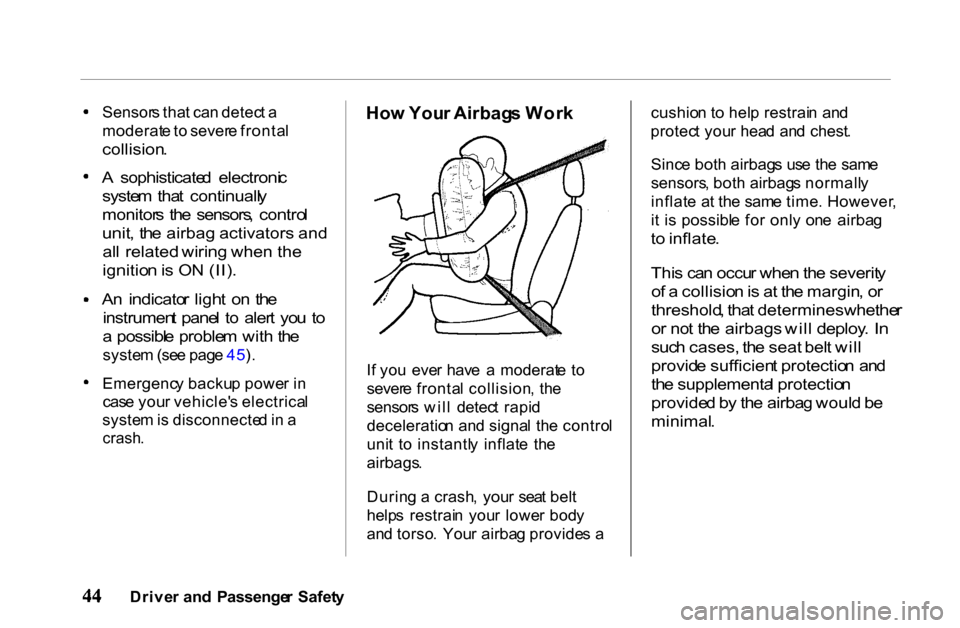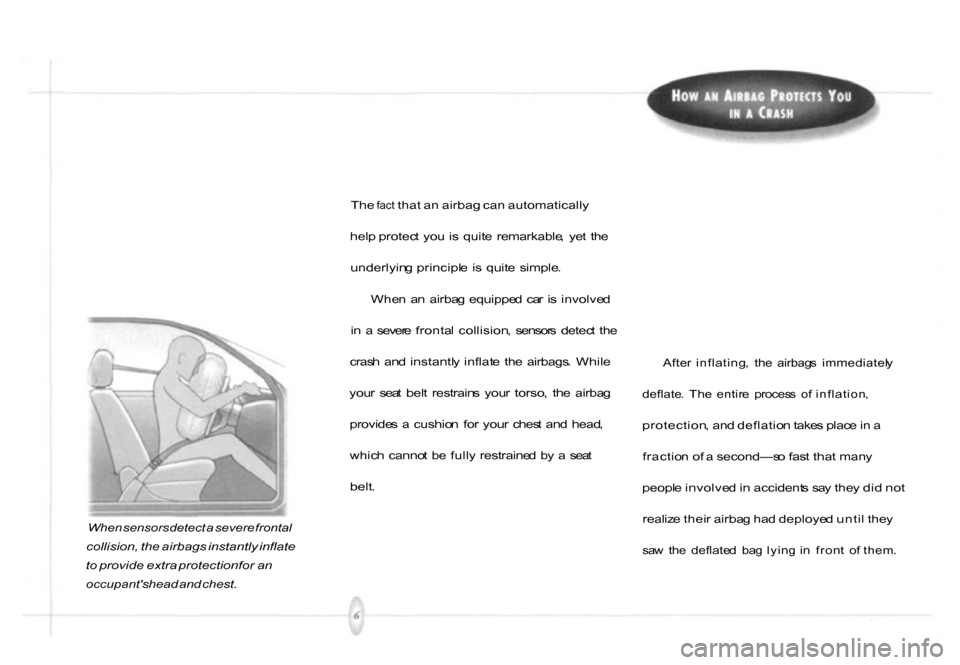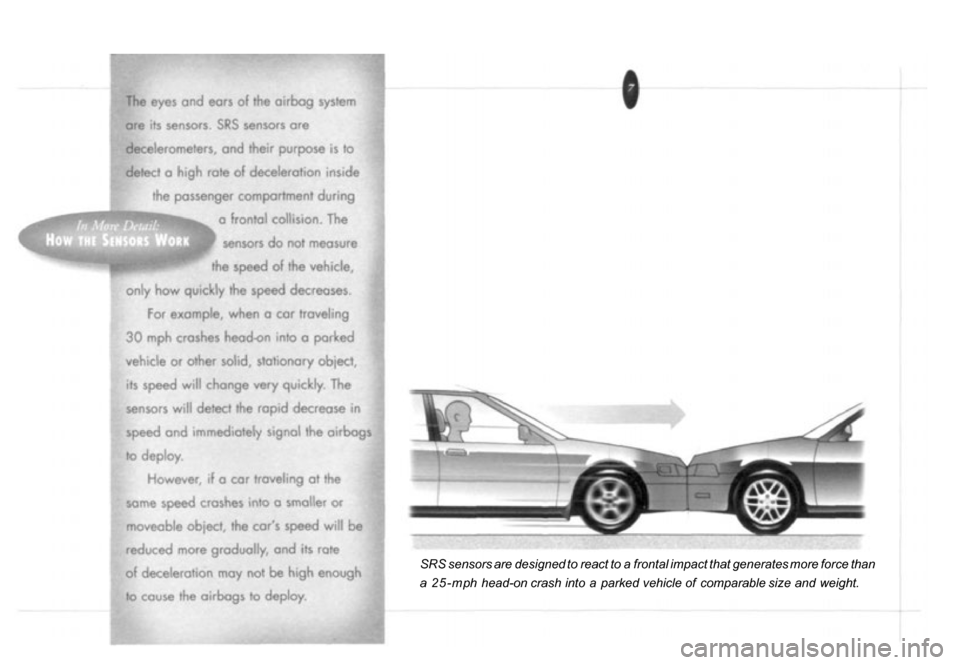sensor HONDA PASSPORT 2001 2.G Owners Manual
[x] Cancel search | Manufacturer: HONDA, Model Year: 2001, Model line: PASSPORT, Model: HONDA PASSPORT 2001 2.GPages: 317, PDF Size: 4.85 MB
Page 48 of 317

Sensor
s tha t ca n detec t a
moderat e to sever e fronta l
collision .
A sophisticate d electroni c
syste m tha t continuall y
monitor s th e sensors , contro l
unit , th e airbag activators and
al l related wiring when the
ignitio n is O N (II) .
A n indicato r ligh t o n th e
instrumen t pane l t o aler t yo u t o
a possibl e proble m wit h th e
syste m (se e pag e 45 ).
Emergenc y backu p powe r i n
cas e you r vehicle' s electrica l
syste m is disconnecte d in a
crash .
Ho
w You r Airbag s Wor k
I f yo u eve r hav e a moderat e t o
sever e fronta l collision , th e
sensor s wil l detec t rapi d
deceleratio n an d signa l th e contro l
uni t t o instantl y inflat e th e
airbags .
Durin g a crash , you r sea t bel t
help s restrai n you r lowe r bod y
an d torso . You r airba g provide s a cushio
n t o hel p restrai n an d
protec t you r hea d an d chest .
Sinc e bot h airbag s us e th e sam e
sensors , bot h airbag s normall y
inflat e a t th e sam e time . However ,
i t i s possibl e fo r onl y on e airba g
t o inflate .
Thi s ca n occu r whe n th e severit y
o f a collisio n is a t th e margin , o r
threshold , tha t determines whether
o r no t th e airbags will deploy . I n
suc h cases, the seat belt wil l
provid e sufficien t protectio n an d
th e supplementa l protectio n
provide d b y th e airba g woul d b e
minimal .
Drive r an d Passenge r Safet y
Page 254 of 317

maintai
n them . Thi s sectio n
summarize s ho w th e emission s
control s work . Schedule d
maintenanc e is o n pag e 204 .
Crankcas e Emission s
Contro l Syste m
You r vehicl e ha s a Positiv e
Crankcas e Ventilatio n System .
Thi s keep s gasse s tha t buil d u p in
th e engine' s Crankcas e fro m goin g
int o th e atmosphere . Th e Positiv e
Crankcas e Ventilatio n valv e route s
the m fro m th e crankcas e bac k t o
th e intak e manifold . The y ar e the n
draw n int o th e engin e an d burned .
Evaporativ e Emission s
Contro l Syste m
A s gasolin e evaporate s i n th e fue l
tank , a n evaporativ e emissio n
contro l caniste r fille d wit h
charcoa l adsorb s th e vapor . I t i s
store d in thi s caniste r whil e th e engin
e i s off . Afte r th e engin e is
starte d an d warme d up , th e vapo r
i s draw n int o th e engin e an d
burne d durin g driving .
Onboar d Refuelin g Vapo r
Recover y
Th e Onboar d Refuelin g Vapo r
Recover y (ORVR ) syste m capture s
th e fue l vapor s durin g refueling .
Th e vapor s ar e adsorbe d in a
caniste r fille d wit h activate d
carbon . Whil e driving , th e fue l
vapor s ar e draw n int o th e engin e
an d burne d off .
Exhaus t Emission s Control s
Th e exhaus t emissio n control s
includ e fou r systems : Fue l
Injection , Ignitio n Timin g Control ,
Exhaus t Ga s Recirculation , an d
Three-Wa y Catalyti c Converter .
Thes e fou r system s wor k togethe r
t o contro l th e engine' s combustio nan
d minimiz e th e amoun t o f HC ,
CO , an d NO x tha t come s ou t th e
tailpipe . Th e exhaus t emissio n
contro l system s ar e separat e fro m
th e crankcase and evaporativ e
emissio n contro l systems .
Fuel Injection System
Th e Fue l Injectio n Syste m use s
sequentia l multipor t fue l injection .
I t ha s thre e subsystems : Ai r
Intake , Engin e Control , an d Fue l
Control . Th e Engin e Contro l
Modul e (ECM ) use s variou s
sensor s t o determin e ho w muc h
ai r i s goin g int o th e engine . I t the n
control s ho w muc h fue l t o injec t
unde r al l operatin g conditions .
Ignition Timing Control System
Thi s syste m constantl y adjust s th e
ignitio n timing , reducin g th e amoun t
o f HC , C O an d NO x produced .
Owne r Assistanc e
Page 303 of 317

When
sensors detect a severe frontal
collision, the airbags instantly inflate
to provide extra protection for an
occupant's head and chest.
Afte
r inflating , th e airbag s immediatel y
deflate . Th e entir e proces s o f inflation ,
protection , an d deflatio n take s plac e in a
fractio n o f a second—s o fas t tha t man y
peopl e involve d in accident s sa y the y di d no t
realiz e thei r airba g ha d deploye d unti l the y
sa w th e deflate d ba g lyin g i n fron t o f them .
The
fact
that an airbag can automatically
hel p protec t yo u i s quit e remarkable , ye t th e
underlyin g principl e i s quit e simple .
Whe n a n airba g equippe d ca r i s involve d
i n a sever e fronta l collision , sensor s detec t th e
cras h an d instantl y inflat e th e airbags . Whil e
you r sea t bel t restrain s you r torso , th e airba g
provide s a cushio n fo r you r ches t an d head ,
whic h canno t b e full y restraine d b y a sea t
belt .
Page 304 of 317

SRS
sensors are designed to react to a frontal impact that generates more force than
a 25-mp h head-on crash into a parked vehicle of comparable size and weight.
Page 317 of 317

bumper
, o r poundin g o n th e steerin g whee l o r
dashboar d wil l no t mak e th e airbag s deploy .
Therefore , th e chanc e o f you r airbag s
deployin g accidentall y i s extremel y rare .
I f you r airbag s eve r deplo y fo r n o apparen t
reason , hav e th e vehicl e inspecte d b y you r
dealer . Mor e tha n likely , th e deale r wil l fin d
undercarriag e damag e indicatin g tha t yo u hi t
a pothol e o r har d raise d objec t i n th e road ,
an d th e airbag s deploye d becaus e th e sensor s
detecte d a momentar y rapi d deceleration .
Can
the airbag s g o off accidentally?
Th e airba g syste m i s extremel y
sophisticate d an d highl y reliable . A n
electroni c syste m continuall y monitor s th e
sensor s an d othe r component s wheneve r
th e ignitio n i s on , an d th e SR S indicato r
ligh t wil l aler t yo u t o an y problem . Har d
braking , slammin g th e doors , kickin g th e